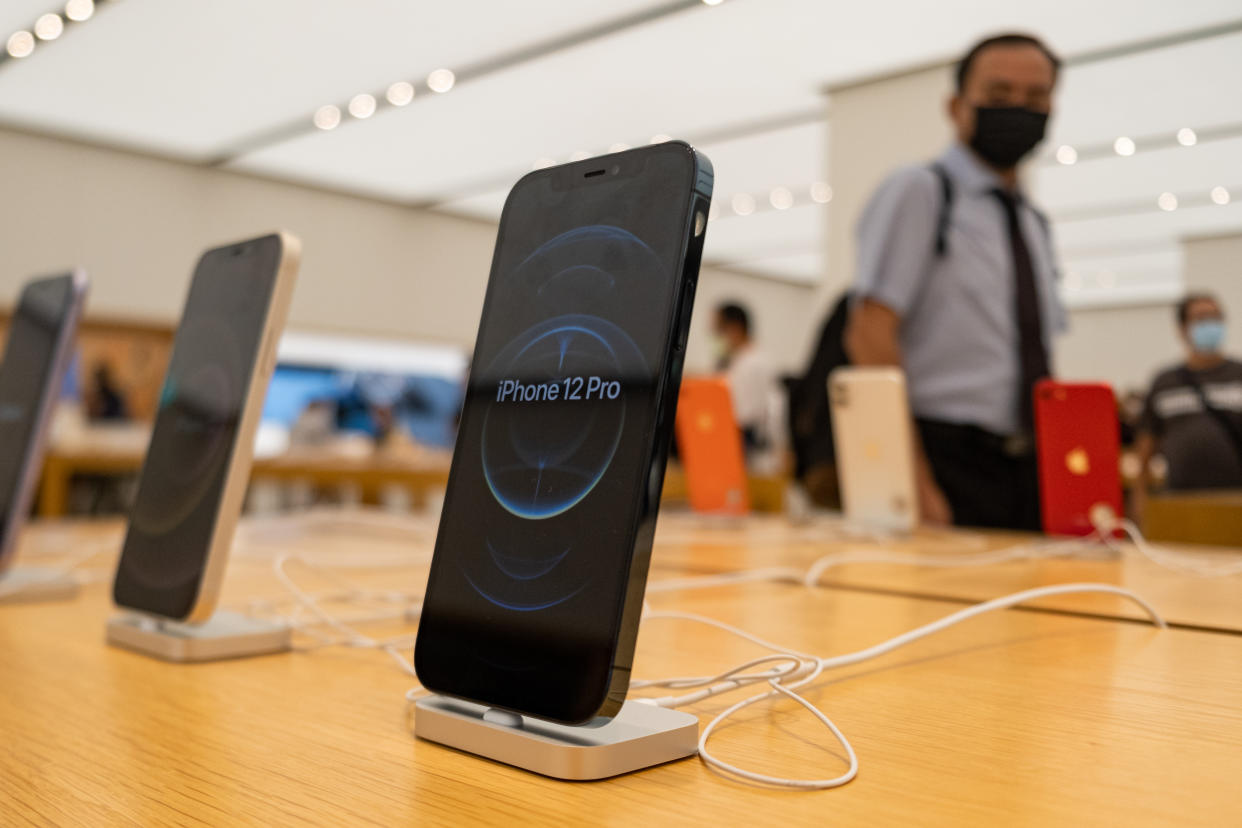Apple's iPhone deconstructed: This 3-D image shows where your iPhone 12 parts come from
The iPhone has revolutionized consumer technology, helping to create an app-based economy and propelling Apple (AAPL) to a $2 trillion market capitalization. After unveiling the iPhones in January 2007, Apple has since sold 2 billion units worldwide, with the phones making up the largest source of the company’s revenue.
And while Apple designs the phone in Cupertino, California, the tech giant sources parts for the phone from manufacturers from across the world. Apple’s latest and greatest, the iPhone 12, is no different, with parts coming from Japan, the U.S., Europe, China, and South Korea.
Here’s where the parts that make up your iPhone come from.
A Samsung display
Apple often relies on Samsung to produce the OLED panels used for the iPhone’s Super Retina XDR display, despite the two tech giants’ rivalry, according to multiple sources including Wired. It also uses panels from Samsung’s competitor, LG, giving the iPhone one of the best smartphone displays around.
In previous generations, Apple used OLED panels for its high-end, Pro iPhone models and LCD panels for the standard iPhone models. LCD panels are generally brighter than OLED, but can’t offer the kind of vibrancy, or power savings, of OLED displays. With the iPhone 12, Apple moved the entire line to OLED, giving all of the phones the same style screen.
A14 Bionic processor
The beating heart of every iPhone 12 is Apple’s A14 Bionic processor. The chip, which is based on UK-based ARM’s architecture and designed by Apple, is among the most advanced smartphone processors in the world.

Using a 5-nanometer design process, something even chip maker Intel hasn’t produced at scale, the A14 features a central processing unit and graphics processing unit, as well as a 16-core neural engine for machine learning capabilities. Inside, the A14 uses two high-powered CPU (central processing unit) cores for resource intensive processes and four less energy intensive CPU cores for dealing with more basic apps.
Camera CMOS image sensor
The iPhone 12 Pro gets three new cameras that allow it to take wide-angle, ultra-wide angle, and telephoto shots. Powering those lenses is Sony’s (SNE) CMOS image sensor.
For the iPhone 12 lineup, Apple added a series of new capabilities across the board. The base iPhone and iPhone mini get two camera lenses, one wide angle the other ultra-wide angle, and a new low-light shooting mode, which was missing from the base iPhone 11.
The iPhone 12 Pro and iPhone 12 Pro Max, meanwhile, get enhanced low-light capture capabilities, as well as that added telephoto lens. On the 12 Pro, the telephoto lens can zoom up to 2x, while the 12 Pro Max can zoom up to 2.5x, giving you a deeper zoom for cleaner looking images captured at a distance.
Battery
One of the most important aspects of any smartphone is its battery. And for the iPhone 12, Apple leaned on Amperex Technology to provide the necessary power to keep its phones running all day.
Apple says the iPhone 12 Pro Max’s battery offers up to 20 hours of video playback on a single charge, while the 12 Pro gets 17 hours. The 12 and 12 mini, meanwhile, get 17 hours and 15 hours, respectively. It makes sense that the larger phones get longer lasting batteries, as their greater sizes mean added room for more robust batteries.
5G antenna
The first iPhones to come with next-generation 5G cellular capabilities, the iPhone 12s perform especially well with consumers. 5G, which is still in its infancy in the U.S., provides far faster network speeds than 4G LTE, leading to improved uploads and downloads and lower latency.
Analysts like Wedbush’s Dan Ives have long predicted a so-called “supercycle” of above average sales for the latest generation thanks to its addition of 5G, and that thesis appears to be correct.
Demand for the phones has led Apple to boost production for the iPhone 12, with the company expected to build 96 million units in the first half of 2021, a 30% year-over-year boost.
While there are rumors that Apple is developing its own 5G chip for future devices, the iPhone 12 relies on Qualcomm’s (QCOM) own 5G module to ensure it can work with current 5G networks.
Memory chip
According to technology repair site iFixit, the iPhone 12’s storage chips are made by Kioxia. The amount of storage you’ll get out of your iPhone comes down to the version you’re opting for. The base iPhone 12 and iPhone 12 mini get 64GB, 128GB, and 256GB of storage. The iPhone 12 Pro and iPhone 12 Pro and iPhone 12 Pro Max get 128GB, 256GB, and 512GB of storage.
One of the most important decisions you’ll make when purchasing your iPhone is the amount of memory to buy. Too little, and you’re going to be deleting photos and apps and leaning on the cloud for storage. Too much, and you’re paying for something you don’t need.
Sign up for Yahoo Finance Tech newsletter
Got a tip? Email Daniel Howley at dhowley@yahoofinance.com over via encrypted mail at danielphowley@protonmail.com, and follow him on Twitter at @DanielHowley.
More from Dan:
Google hit with a third antitrust suit — this time by 38 attorneys general
Apple and Facebook are locked in an ‘Epic’ battle over privacy
Google sued by Texas and 9 other states accusing it of ‘antitrust evils’
Follow Yahoo Finance on Twitter, Facebook, Instagram, Flipboard, SmartNews, LinkedIn, YouTube, and reddit.

